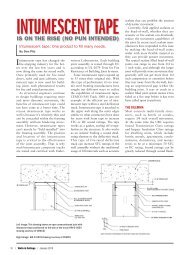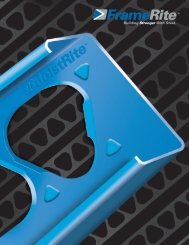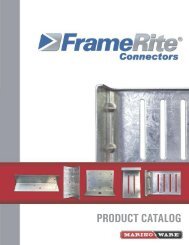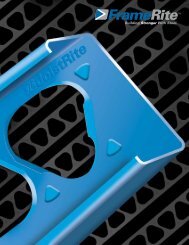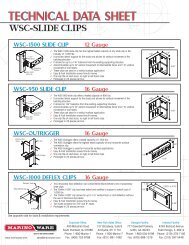10015 MWA Drywall Blue Cat.qxd - Marino\WARE
10015 MWA Drywall Blue Cat.qxd - Marino\WARE
10015 MWA Drywall Blue Cat.qxd - Marino\WARE
You also want an ePaper? Increase the reach of your titles
YUMPU automatically turns print PDFs into web optimized ePapers that Google loves.
APPLICATION:<br />
For selection of non-load bearing interior wall framing subjected to uniform loads.<br />
USE:<br />
Select a stud, in terms of spacing (inches on center) lateral load (PSF), and deflection limit which provides an<br />
allowable height, in feet, equal to or greater than the actual project requirements.<br />
NOTES FOR COMPOSITE:<br />
1. Limiting heights are based on the stud with the contribution due to the attachment of the gypsum wallboard.<br />
2. Composite wall sheathed both sides full height with �� " gypsum wallboard for 18 and 30 mil.<br />
3. The use of these tables are limited to applications involving simply supported conditions (i.e. laterally supported<br />
at each end). Applications involving the installation of handrails, brackets, etc. require further analysis.<br />
4. Check end reactions for web crippling. Where the web height to thickness ratio of the stud exceeds 200 bearing<br />
stiffeners are required at support locations.<br />
6<br />
LIMITING HEIGHTS, FT. - IN.<br />
NOTES FOR NON-COMPOSITE:<br />
1. Limiting heights are based on the stud alone without contribution due to the attachment of the gypsum wallboard.<br />
2. Limiting heights based on continuous support of each flange over the full length of the stud by the proper<br />
attachment of gypsum wallboards or other sheathing products of equivalent or greater strength applied full height<br />
to each side of the wall. Mechanical bridging, spaced at vertical intervals not to exceed 5'-0" on center, may be<br />
substituted in conditions where sheathing is not installed full height each side or to one side only. Reductions in<br />
allowable bending capacities must be investigated separately.<br />
3. The use of these tables are limited to applications involving simply supported conditions (i.e. laterally supported<br />
at each end). Applications involving the installation of handrails, brackets, etc. require further analysis.<br />
4. Heights indicated are based on steel stud properties only.<br />
5. Check end reactions for web crippling. Where the web height to thickness ratio of the stud exceeds 200 bearing<br />
stiffeners are required at support locations.



